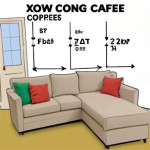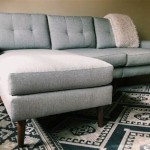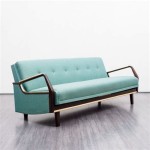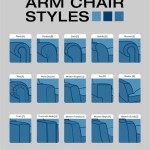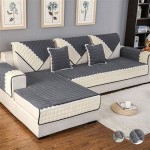Average Sofa Back Height: A Comprehensive Guide in Centimeters and Inches
The selection of a sofa involves careful consideration of numerous factors, including style, material, comfort, and size. An often-overlooked yet crucial dimension is the back height of the sofa. This measurement significantly impacts both the aesthetic appeal and the ergonomic comfort provided by the furniture piece. Understanding the average sofa back height, expressed in both centimeters (cm) and inches, is essential for making informed decisions when purchasing or designing living spaces.
Sofa back height broadly influences the posture and support offered to the user. A back that is too low may result in insufficient support for the upper back and neck, leading to discomfort during extended periods of seating. Conversely, a back that is excessively high can create a sense of confinement and visual imbalance within the room. This article aims to provide a detailed exploration of average sofa back heights, encompassing variations, factors affecting these dimensions, and guidelines for selecting the most appropriate back height for individual needs and spatial constraints.
The discussion will primarily focus on standard sofa designs encountered in residential settings. Custom designs or specialized seating arrangements, such as sectional sofas with varying back heights, are beyond the scope of this article. The measurements provided represent general averages and should be considered as guidelines rather than absolute values, as manufacturers' specifications can vary considerably.
Understanding Average Sofa Back Height Dimensions
The average sofa back height typically falls within a range, reflecting the diversity of sofa styles and design philosophies. A common range for sofa back height is between 76 cm (30 inches) and 91 cm (36 inches). This range represents the distance from the floor to the highest point of the sofa back. However, it is important to differentiate between the overall height and the height of the back cushion, which contributes to the perceived support and comfort.
Lower-backed sofas, often associated with contemporary or mid-century modern designs, may have back heights as low as 68 cm (27 inches). These sofas prioritize a streamlined aesthetic and may offer less upper back support. Higher-backed sofas, exceeding 91 cm (36 inches), are frequently found in more traditional styles and are designed to provide more comprehensive support, extending to the neck and head. These higher backs are often associated with increased comfort, particularly for taller individuals.
The measurement process involves using a measuring tape or ruler to determine the vertical distance from the floor to the uppermost point of the sofa back. This measurement should be taken with the sofa placed on a level surface to ensure accuracy. If the sofa features removable back cushions, it is advisable to measure both with and without the cushions in place to gain a comprehensive understanding of the overall and functional back height.
Factors Influencing Sofa Back Height
Several factors contribute to the variations observed in sofa back heights. These include design aesthetics, ergonomic considerations, intended use, and the overall style of the sofa. Each factor plays a critical role in determining the optimal back height for a specific sofa model.
Design Aesthetics: The visual appeal of a sofa is paramount, and the back height is an integral element of the overall design. Low-backed sofas often contribute to a minimalist or modern aesthetic, emphasizing horizontal lines and creating a sense of spaciousness. In contrast, high-backed sofas can convey a more traditional or formal ambiance, providing a sense of grandeur and enclosure. Sofa designers carefully consider the back height to achieve the desired visual effect.
Ergonomic Considerations: The primary function of a sofa is to provide comfortable seating. The back height directly influences the level of support offered to the user's back, neck, and shoulders. Sofas designed for extended periods of relaxation, such as those found in home theater settings, often feature higher backs to provide more comprehensive support. Sofas intended for more formal seating arrangements may prioritize a lower back height for a more upright posture.
Intended Use: The intended use of the sofa significantly affects the ideal back height. A sofa intended for casual lounging in a family room may benefit from a higher back for added comfort during movie nights or reading sessions. Conversely, a sofa placed in a formal living room, primarily used for receiving guests, may prioritize a lower back height for a more sophisticated and streamlined appearance. The anticipated activities and user preferences should guide the selection of the appropriate back height.
Sofa Style: Different sofa styles inherently feature varying back heights. Chesterfield sofas, characterized by their tufted backs and rolled arms, typically have higher backs to enhance their traditional and luxurious appearance. Mid-century modern sofas often feature lower backs, reflecting the minimalist design principles of the era. Lawson sofas, known for their comfortable and versatile design, generally have medium-height backs that offer a balance of support and aesthetic appeal. The inherent style of the sofa dictates, to a large extent, the typical back height range.
Guidelines for Selecting the Right Sofa Back Height
Choosing the optimal sofa back height requires careful consideration of personal preferences, room dimensions, and intended use. Several guidelines can assist in making an informed decision that balances comfort, aesthetics, and functionality.
Consider Individual Height and Posture: The height of the user is a crucial factor in determining the appropriate sofa back height. Taller individuals generally require higher backs to provide adequate support for their upper back and neck. Shorter individuals may find lower-backed sofas more comfortable, as they may not need the additional support. The user's typical sitting posture should also be considered. Individuals who prefer to sit upright may benefit from a lower back height, while those who tend to slouch or recline may require a higher back for optimal support.
Assess Room Dimensions and Layout: The size and layout of the room play a significant role in determining the ideal sofa back height. In smaller rooms, a lower-backed sofa can help to create a sense of spaciousness and prevent the furniture from overwhelming the space. Higher-backed sofas may be more suitable for larger rooms, where they can serve as a focal point and provide a sense of grandeur. The overall layout of the room, including the placement of windows, doors, and other furniture, should be considered to ensure that the sofa back height complements the existing design elements.
Evaluate Functional Requirements: The primary function of the sofa should guide the selection of the back height. If the sofa is intended for frequent lounging and relaxation, a higher back with ample cushioning may be preferable. If the sofa is primarily used for formal seating or occasional gatherings, a lower back may be sufficient. Consider the anticipated activities and user preferences when determining the functional requirements of the sofa and selecting an appropriate back height.
Test Before Purchasing: Whenever possible, it is advisable to test the sofa in person before making a purchase. Sit on the sofa and assess the level of support provided by the back. Ensure that the back height is comfortable and provides adequate support for your upper back and neck. Consider bringing along other family members or individuals who will be using the sofa to gather their feedback and ensure that the back height is suitable for a variety of users. This practical evaluation can significantly improve the likelihood of selecting a sofa with an appropriate back height.
Consider Customization Options: In some cases, it may be possible to customize the back height of a sofa to meet specific needs or preferences. Some manufacturers offer the option to adjust the back height during the production process, allowing for a tailored fit. Upholstery shops may also be able to modify the back height of an existing sofa, although this may involve significant alterations and costs. Exploring customization options can be a viable solution for individuals with unique requirements or those seeking a perfect fit.
By carefully considering these guidelines and factors, individuals can make informed decisions about sofa back heights, ensuring a comfortable, aesthetically pleasing, and functional addition to their living spaces. The measurements provided in centimeters and inches serve as a valuable reference point, facilitating a more precise and informed selection process.

The Perfect Sofa Backrest Height Explained By Experts Cozylant

Sofa Dimensions For 2 3 4 5 6 Person Couches Diagrams Included Home Stratosphere

Sofa Dimensions For 2 3 4 5 6 Person Couches Diagrams Included Home Stratosphere

Standard Sofa Dimensions For 2 3 4 And 5 Person Charts Diagrams Engineering Discoveries

Sofa Dimensions For 2 3 4 5 6 Person Couches Diagrams Included Home Stratosphere

Sofa Dimensions For 2 3 4 5 6 Person Couches Diagrams Included Home Stratosphere

Sofa Size Calculator

Nill Astonic 2 Seater Fabric Sofa Beige

L Shape Sofa Dimensions How To Ensure It Fits Your Room

Standard Sofa Sizes How To Choose The Right Size

